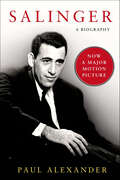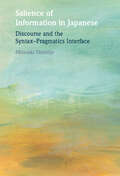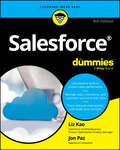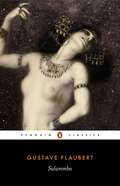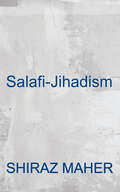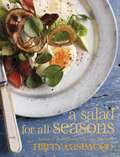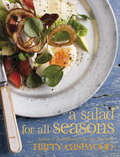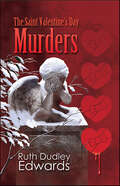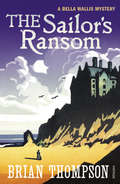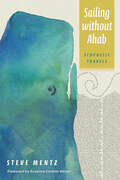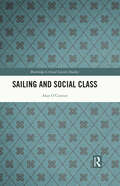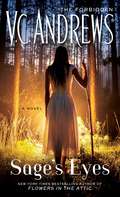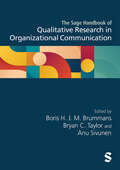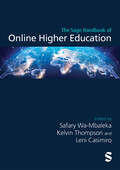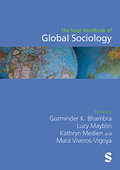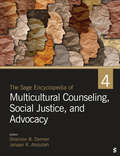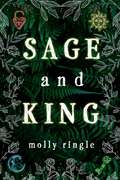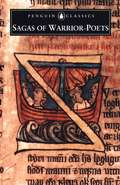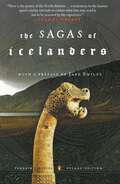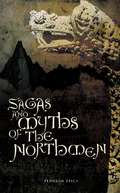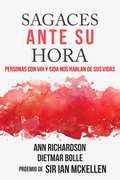- Table View
- List View
Salinger: A Biography
by Paul AlexanderJ.D. Salinger was one of the twentieth century's greatest writers. He was also one of its most elusive. After making his mark on the American literary scene, Salinger retreated to a small town in New Hampshire where he hoped to hide his life away from the world. With dogged determination, however, journalist and biographer Paul Alexander captured Salinger's story in this, the only complete biography of Holden Caulfield's creator published to date. Using the archives at Princeton, Yale, Harvard, Columbia, NYU and the New York Public Library as well as research in New York and New Hampshire, Alexander has created a great biography of Salinger that's further enriched by interviews with some of the greatest literary figures of our time: George Plimpton, Gay Talese, Ian Hamilton, Harold Bloom, Roger Angell, A. Scott Berg, Robert Giroux, Ved Mehta, Gordon Lish and Tom Wolfe.
Salience of Information in Japanese: Discourse and the Syntax–Pragmatics Interface
by null Mitsuaki Shimojo'Salience' is a linguistic phenomenon whereby information that is 'given', or 'new', is distributed and presented within a sentence in particular ways that convey its relevance. Although it has been widely described as the speaker's linguistic choices based on the hearer's perspective, it has received less attention as the speaker's manipulations of the hearer's cognitive states. This timely study redresses that balance by analysing several morphosyntactic phenomena in Japanese, drawing on a wide range of authentic language examples. Taking a functionalist perspective, it brings together studies of grammar and discourse, which are often described separately, and deploys the combined grammar-discourse approach in Role and Reference Grammar, the structural-functionalist theory in which syntax, semantics, and pragmatics are equally central to our understanding of language. It also offers an analysis of second language (L2) learners' Japanese discourse, and demonstrates the relevance of that analysis to issues outside of traditional second language research.
Salesforce For Dummies
by Liz Kao Jon PazYour easy-to-follow guide to the world’s leading cloud-based CRM software Salesforce gives your business an edge in tracking relationships and managing sales, marketing, customer service, and support operations. Salesforce For Dummies help you take advantage of key platform functionality and focus on making the most of its many features. Learn best practices to determine the right configuration to suit your business needs, and how to use apps, build widgets, and configure features to personalize your system for your business. Explore prospecting for leads, managing accounts, maintaining contacts, tracking products, calculating forecasts, and monitoring each customer’s service and support interactions with your business. Collaborate with colleagues by sharing information across a 360-degree view of all customer interactions, enhance your online marketing, gain real-time visibility into sales, and close deals faster. Get started with configuring Salesforce and set up the apps that your business needs Discover the latest updates to Salesforce, including Flow Builder, Lightning, and Einstein Improve business performance with reporting insights, collaborative communication features, and integrated sales and marketing processes Find new ways to improve productivity and reduce administration timeSalesforce For Dummies is the fully updated, best-selling guide that helps new and existing users get up to speed with the world’s top CRM.
Salammbo
by Gustave FlaubertAn epic story of lust, cruelty, and sensuality, this historical novel is set in Carthage in the days following the First Punic War with Rome.
Salafi-jihadism: The History Of An Idea
by Shiraz MaherNo topic has captured the public imagination of late quite so dramatically as the specter of global jihadism. While much has been said about the way jihadists behave, their ideology remains poorly understood. As the Levant has imploded and millenarian radicals claim to have revived a Caliphate based on the teachings of the Prophet Mohammed, the need for a nuanced and accurate understanding of jihadist beliefs has never been greater. Shiraz Maher charts the intellectual underpinnings of salafi-jihadism from its origins in the mountains of the Hindu Kush to the jihadist insurgencies of the 1990s and the 9/11 wars. What emerges is the story of a pragmatic but resilient warrior doctrine that often struggles - as so many utopian ideologies do - to consolidate the idealism of theory with the reality of practice.
A Salad for All Seasons - Bite Sized Edition: Delicious, Uplifting And Easy Recipes For The Whole Year
by Harry EastwoodA mouthwatering collection of twenty seasonal salad recipes from the author of Red Velvet and Chocolate HeartacheLet’s eat more salad! It’s fresh, colourful and healthy fast food. A far cry from the ‘rabbit food’ image of old, salads are now rightfully top of the menu. In A Salad for All Seasons, Harry Eastwood shakes things up, introducing us to original and easy-to-make salads to see you through the year. From well-loved favourites to exotic delights inspired by Harry’s travels and love of fresh ingredients, A Salad for All Seasons is the ultimate proof that natural, fresh and nutritious food can also be a feast – the whole year round.
A Salad for All Seasons: Delicious, uplifting and easy recipes for the whole year
by Harry Eastwood'Quick and simple to prepare, delicious and good for you.' BBC Good Food'Stunning . . . delicious food that makes you feel good.' Tasty Magazine 'Harry's down-to-earth recipes make cooking effortless.' Sainsbury's Magazine___In A Salad for All Seasons, Harry Eastwood introduces us to over 100 delicious, original and easy-to-make salads to see you through the year.Spring and Summer are packed with vibrant, exciting recipes that can be knocked up in minutes, such as Peach and Mozarella with Sweet Chilli and Tomato Glaze and Thai Beef and Basil with Noodles, while Autumn and Winter offer warm, hearty, nourishing combinations, such as Roasted Squash with Thyme and Taleggio and Spinach, Lamb and Fig with Orange and Honey Dressing.From well-loved favourites to exotic delights inspired by Harry's travels and love of fresh ingredients, A Salad for All Seasons is the ultimate proof that natural, fresh and nutritious food can also be a feast - the whole year round.___Readers love cooking with A Salad for all Seasons:'Really tasty, healthy dishes that are easy to prepare . . . great book.''An enjoyable, comforting and inspiring book, with lovely recipes that have the whole family clearing their plates.''I've never cooked so many recipes from a book . . . this book is fantastic.'u. In A Salad for All Seasons, Harry Eastwood shakes things up, introducing us to over 100 delicious, original and easy-to-make salads to see you through the year. Spring and Summer are packed with vibrant, exciting recipes that can be knocked up in minutes, such as Peach and Mozarella with Sweet Chilli and Tomato Glaze and Thai Beef and Basil with Noodles, while Autumn and Winter offer warm, hearty, nourishing combinations, such as Roasted Squash with Thyme and Taleggio and Spinach, Lamb and Fig with Orange and Honey Dressing. From well-loved favourites to exotic delights inspired by Harry's travels and love of fresh ingredients, A Salad for All Seasons is the ultimate proof that natural, fresh and nutritious food can also be a feast - the whole year round.
The Saint Valentine's Day Murders: A Robert Amiss Mystery (Robert Amiss/Baroness Jack Troutbeck Mysteries #2)
by Ruth Dudley Edwards"The plotting and the mechanics of the solution are in the best traditions of the classic British mystery...Try not to miss this one." —New York TimesLife in a dismal bureaucratic cul-de-sac is not what Robert Amiss expects when the British civil service lends him for a year to the British Conservation Corporation. In fact, he finds himself condemned to a non-job in a backwater, managing disgruntled and demoralized timeservers who deeply resent him. Morale is not improved by the arrival of Melissa, a radical feminist lesbian separatist. Only Amiss's sense of humour and the joys of visiting Rachel, his new love in Paris, keep him sane.The malice, envy and anger that burgeons among the filing cabinets is first expressed in pettiness and then in unpleasant practical jokes. Then it escalates and finally culminates in callous murder by means of boxes of poisoned chocolates sent to the bureaucrats' wives.With the help of Ellis Pooley, a young detective obsessed with fictional sleuths, Amiss and his friend, Superintendent Milton, search for motives in an office where marital discord and broken dreams might drive anyone to murder.
The Sailor's Ransom: A Bella Wallis Mystery (Bella Wallis Victorian Mysteries #2)
by Brian ThompsonLondon is alive with gossip about the thrilling new book by sensationalist author Henry Ellis Margam, but only a select group of people know that the real author is beautiful widow, and member of high society, Bella Wallis.One of her confidantes is the dashing Philip Westland, who comes to Bella now with a problem: his best friend Kennet is smitten with the heiress Mary Skillane but Mary's father, Sir William, has promised her to Robert Judd, a vulgar treasure-seeker. Mary is due to inherit the Skillane pearls, which are currently residing in a Cornsih bank vault, but it seems that the pearls were ill-gotten.Can Bella and her friends reunite the young lovers and escape the attention of the villainous Judd?
Sailing without Ahab: Ecopoetic Travels
by Steve MentzJourney through uncharted literary waters and explore Melville’s epic in bold new lightCome sail with I.We’re not taking the same trip, though you might recognize the familiar course. This time, the Pequod’s American voyage steers its course across the curvature of the Word Ocean without anyone at the helm. We are leaving one man and his madness on shore. Our ship overflows with glorious plurality—multiracial, visionary, queer, conflicted, polyphonic, playful, violent. But on this voyage something is different. Today we sail headless without any Captain. Instead of binding ourselves to the dismasted tyrant’s rage, the ship’s crew seeks only what we will find: currents teeming with life, a blue-watered alien globe, toothy cetacean smiles from vasty deeps. Treasures await those who sail without.This cycle of one hundred thirty-eight poems—one for each chapter in Moby-Dick, plus the Etymology, Extracts, and Epilogue—launches into oceanic chaos without the stabilizing mad focus of the Nantucket captain. Guided by waywardness and curiosity, these poems seek an alien ecopoetics of marine depths, the refraction of light, the taste of salt on skin. Directionless, these poems reach out to touch oceanic expanse and depth. It’s not an easy voyage, and not a certain one. It lures you forward. It has fixed its barbed hook in I.Sailing without means relinquishing goals, sleeping at the masthead, forgetting obsessions. I welcome you to trace wayward ways through these poems. Read them any way you can—back to front, at random, sideways, following the obscure promptings of your heart. It’s the turning that matters. It’s a blue wonder world that beckons.
Sailing and Social Class (Routledge Critical Leisure Studies)
by Alan O'ConnorThis book explores the sociology of sailing and yachting. Drawing on original research, and employing a theoretical framework based on the work of Pierre Bourdieu, the book argues that sailing is, still, an upper-middle-class activity that has much to tell us about the wider sociology of leisure and sport. The book examines the historical foundations of blue-water sailing as established by naval and colonial shipping, to trace the roots of contemporary sailing and yachting culture. It also examines archives of sailing narratives and cruising guides, as well as the children’s books of Arthur Ransome, arguing that this archival material offers a social rather than a psychological interpretation of the ‘bodily investment’ in sailing. The book uses Bourdieu’s concepts of ‘illusio’ – an investment of time, emotion and body into a worthwhile activity – and ‘habitus’, or lifeworld, alongside contemporary data sets, to examine the yacht club as a social institution, including why many boats never go out on the water, the relationship between yacht clubs and the state, and social issues as manifested in yacht clubs, such as sexism, racism and homophobia. Offering a vigorous sociological critique of yachting and sailing, this book is fascinating reading for anybody with an interest in the sociology of leisure and sport, subcultures, social theory, or social issues in wider society.
Sage's Eyes
by V.C. AndrewsFrom V.C. Andrews, bestselling author of Flowers in the Attic (the first in a series of Lifetime movie events about the Dollanganger family), comes the tale of a young girl kept under the watchful eye of her adoptive parents, as if they fear who—or what—she’ll become…Sixteen-year-old Sage is a lonely child. Her adoptive parents watch her obsessively, as if studying her for warning signs of…something. And maybe they’re right to—even she can’t make sense of the strange things she sees and hears. She possesses knowledge that other teenagers don’t, that her parents and teachers—no adult—could possibly have. So when Sage finally makes a friend who understands her alarming gift, he becomes her confidant, a precarious link to the truth about who she really is. For Sage and the alluring new boy at school share many things in common. Perhaps, they’ll learn, far too many things.
The Sage Handbook of Qualitative Research in Organizational Communication
by Boris H. J. M. Brummans Bryan C. Taylor Anu SivunenThe Sage Handbook of Qualitative Research in Organizational Communication is a state-of-the-art resource for scholars, students, and practitioners seeking to deepen their understanding and expertise in this dynamic field. Written by a global team of established and emerging experts, this Handbook provides a comprehensive exploration of the field’s foundational traditions of epistemology and theory, as well as its latest methodologies, methods, issues, and debates. The volume reflects a diverse range of approaches (e.g., mixed-methods, ethnographic, rhetorical, pragmatist, phenomenological, feminist, critical race, postcolonial, queer, and engaged), and covers a broad spectrum of topics ranging from data collection and analysis, to representation. Additionally, this Handbook addresses emerging trends such as digital forensics, post-qualitative research, and the transformative impact of COVID-19 on the conduct of qualitative research in organizational communication. As the first volume of its kind in this field, The Sage Handbook of Qualitative Research in Organizational Communication is a cornerstone text for scholars, students, and practitioners interested in understanding the vital role of communication in organizational life. Part 1: Approaches to Qualitative Organizational Communication Research Part 2: Data Collection in Qualitative Organizational Communication Research: Methods and Issues Part 3: Data Analysis and Representation in Qualitative Organizational Communication Research: Methods and Issues Part 4: The Future of Qualitative Organizational Communication Research
The Sage Handbook of Qualitative Research in Organizational Communication
by Boris H. J. M. Brummans Bryan C. Taylor Anu SivunenThe Sage Handbook of Qualitative Research in Organizational Communication is a state-of-the-art resource for scholars, students, and practitioners seeking to deepen their understanding and expertise in this dynamic field. Written by a global team of established and emerging experts, this Handbook provides a comprehensive exploration of the field’s foundational traditions of epistemology and theory, as well as its latest methodologies, methods, issues, and debates. The volume reflects a diverse range of approaches (e.g., mixed-methods, ethnographic, rhetorical, pragmatist, phenomenological, feminist, critical race, postcolonial, queer, and engaged), and covers a broad spectrum of topics ranging from data collection and analysis, to representation. Additionally, this Handbook addresses emerging trends such as digital forensics, post-qualitative research, and the transformative impact of COVID-19 on the conduct of qualitative research in organizational communication. As the first volume of its kind in this field, The Sage Handbook of Qualitative Research in Organizational Communication is a cornerstone text for scholars, students, and practitioners interested in understanding the vital role of communication in organizational life. Part 1: Approaches to Qualitative Organizational Communication Research Part 2: Data Collection in Qualitative Organizational Communication Research: Methods and Issues Part 3: Data Analysis and Representation in Qualitative Organizational Communication Research: Methods and Issues Part 4: The Future of Qualitative Organizational Communication Research
The Sage Handbook of Online Higher Education
by Safary Wa-Mbaleka Kelvin Thompson Leni CasimiroThe SAGE Handbook of Online Higher Education presents a cutting-edge collection of 50 essays that explores the rapidly evolving landscape of online teaching and learning in higher education. Assembled and contributed by a team of leading experts, the Handbook adopts a uniquely holistic approach to examining the needs of online education. Chapters bring together voices from diverse and international backgrounds to provide insights applicable to a broad range of contexts, and present practical strategies for planning, delivering quality online higher education. The handbook covers a wide range of topics, including online pedagogy, instructional design, student engagement, technological innovation, assessment, leadership, and the developing role of online education in the context of broader societal and cultural shifts. The SAGE Handbook of Online Higher Education is an essential resource for educators, researchers, policymakers, and practitioners who seek to understand and shape the future of higher education in the digital age. Section 1: Fundamentals of Online Education Section 2: Online Education Around the World Section 3: Online Instructional Design Section 4: Online Instructional Delivery Section 5: Instructional Technology for Online Education Section 6: Online Education Administration and Management Section 7: Student Support Services
The Sage Handbook of Online Higher Education
by Safary Wa-Mbaleka Kelvin Thompson Leni CasimiroThe SAGE Handbook of Online Higher Education presents a cutting-edge collection of 50 essays that explores the rapidly evolving landscape of online teaching and learning in higher education. Assembled and contributed by a team of leading experts, the Handbook adopts a uniquely holistic approach to examining the needs of online education. Chapters bring together voices from diverse and international backgrounds to provide insights applicable to a broad range of contexts, and present practical strategies for planning, delivering quality online higher education. The handbook covers a wide range of topics, including online pedagogy, instructional design, student engagement, technological innovation, assessment, leadership, and the developing role of online education in the context of broader societal and cultural shifts. The SAGE Handbook of Online Higher Education is an essential resource for educators, researchers, policymakers, and practitioners who seek to understand and shape the future of higher education in the digital age. Section 1: Fundamentals of Online Education Section 2: Online Education Around the World Section 3: Online Instructional Design Section 4: Online Instructional Delivery Section 5: Instructional Technology for Online Education Section 6: Online Education Administration and Management Section 7: Student Support Services
The Sage Handbook of Global Sociology
by Gurminder K. Bhambra Lucy Mayblin Kathryn Medien Mara Viveros-VigoyaThe SAGE Handbook of Global Sociology addresses the ‘social’, its various expressions globally, and the ways in which such understandings enable us to understand and account for global structures and processes. It demonstrates the vitality of thought from around the world by connecting theories and traditions, including reflections on European colonization, to build shared, rather than universal, understandings. Across 36 chapters, the Handbook offers a series of perspectives and cases from different locations, enabling the reader better to understand the particularities of specific contexts and how they are connected to global movements and structures. By moving beyond standard accounts of sociology and social theory, this Handbook offers both valuable insight into and scholarly contribution to the field of global sociology. Part 1: Politics Part 2: Labour Part 3: Kinship Part 4: Belief Part 5: Technology Part 6: Ecology
The Sage Handbook of Global Sociology
by Gurminder K. Bhambra Lucy Mayblin Kathryn Medien Mara Viveros-VigoyaThe SAGE Handbook of Global Sociology addresses the ‘social’, its various expressions globally, and the ways in which such understandings enable us to understand and account for global structures and processes. It demonstrates the vitality of thought from around the world by connecting theories and traditions, including reflections on European colonization, to build shared, rather than universal, understandings. Across 36 chapters, the Handbook offers a series of perspectives and cases from different locations, enabling the reader better to understand the particularities of specific contexts and how they are connected to global movements and structures. By moving beyond standard accounts of sociology and social theory, this Handbook offers both valuable insight into and scholarly contribution to the field of global sociology. Part 1: Politics Part 2: Labour Part 3: Kinship Part 4: Belief Part 5: Technology Part 6: Ecology
The Sage Encyclopedia of Multicultural Counseling, Social Justice, and Advocacy
by Shannon B. Dermer Jahaan R. AbdullahSince the late 1970s, there has been an increase in the study of diversity, inclusion, race, and ethnicity within the field of counseling. The SAGE Encyclopedia of Multicultural Counseling, Social Justice, and Advocacy will comprehensively synthesize a wide range of terms, concepts, ideologies, groups, and organizations through a diverse lens. This encyclopedia will include entries on a wide range of topics relative to multicultural counseling, social justice and advocacy, and the experiences of diverse groups. The encyclopedia will consist of approximately 600 signed entries, arranged alphabetically within four volumes.
The Sage Encyclopedia of Multicultural Counseling, Social Justice, and Advocacy
by Shannon B. Dermer Jahaan R. AbdullahSince the late 1970s, there has been an increase in the study of diversity, inclusion, race, and ethnicity within the field of counseling. The SAGE Encyclopedia of Multicultural Counseling, Social Justice, and Advocacy will comprehensively synthesize a wide range of terms, concepts, ideologies, groups, and organizations through a diverse lens. This encyclopedia will include entries on a wide range of topics relative to multicultural counseling, social justice and advocacy, and the experiences of diverse groups. The encyclopedia will consist of approximately 600 signed entries, arranged alphabetically within four volumes.
Sage and King
by Molly RingleWhen the queen of Lushrain is murdered, her unprepared youngest brother gets thrown into the spotlight as the new king. He&’s soon assigned a charming young magician who&’s meant to protect him from the assassin, and they grow romantically close—which comes with a host of dangerous complications and secrets. Zaya expected to be the irresponsible youngest prince his whole life. But when his two older siblings are killed by an unidentified magician, he finds himself crowned king of Lushrain—the end of his liberty as he knows it. As part of his training, he&’s sent to Heartwood for a month, the house of the sages high in the mountains. There, to his shock, the sages tell him he must learn about magic—which is illegal to practice, but has nonetheless been among Heartwood&’s secret studies for centuries. They assign Col as his tutor, a charming young sage with unusually strong powers. Zaya abhors and distrusts magic, and Col absolutely doesn&’t want the job of attempting to change the king&’s mind. But in their lessons and debates, they grow closer and begin envisioning a future in which a sage and a king might make a harmonious couple. But the assassin still roams, seeking to hurt Zaya, and the budding love affair may be crushed by the secrets that Heartwood—and Col—have kept about this killer. Molly Ringle's growing list of other successful titles include:The Chrysomelia Stories 1. Persephone's Orchard 2. Underworld's Daughter 3. Immortal's Spring All the Better Part of Me Lava Red Feather Blue The Goblins of Bellwater
Sagas of Warrior-poets
by Leifur EirickssonKormak's Saga, The Saga of Hallfred Troublesome-Poet, The Saga of Gunnlaug Serpent-Tongue, The Saga of Bjorn, Champion of the Hitardal People, Viglund's Saga Set in the farmsteads of Viking age Iceland at a time when the old ethos of honour and heroic adventure merged with new ideas of romantic infatuation, each of these sagas features poet heroes, complex love triangles, and travels to foreign lands.
The Sagas of the Icelanders: Homegrown Stereotypes And Foreign Influences (Skaldic Poetry Of The Scandinavian Middle Ages Ser. #5)
by Jane SmileyIn Iceland, the age of the Vikings is also known as the Saga Age. A unique body of medieval literature, the Sagas rank with the world’s great literary treasures – as epic as Homer, as deep in tragedy as Sophocles, as engagingly human as Shakespeare. Set around the turn of the last millennium, these stories depict with an astonishingly modern realism the lives and deeds of the Norse men and women who first settled in Iceland and of their descendants, who ventured farther west to Greenland and, ultimately, North America. Sailing as far from the archetypal heroic adventure as the long ships did from home, the Sagas are written with psychological intensity, peopled by characters with depth, and explore perennial human issues like love, hate, fate and freedom.
Sagas and Myths of the Northmen
by Jesse ByockIn a land of ice, great warriors search for glory...When a dragon threatens the people of the north, only one man can destroy the fearsome beast. Elsewhere, a mighty leader gathers a court of champions, including a noble warrior under a terrible curse. The Earth's creation is described; tales of the gods and evil Frost Giants are related; and the dark days of Ragnarok foretold.Journey into a realm of legend, where heroes from an ancient age do battle with savage monsters, and every man must live or die by the sword ...
Sagaces ante su hora: Personas con VIH y SIDA nos hablan de sus vidas
by Ann Richardson Dietmar BolleSon jóvenes y tienen una enfermedad letal. Es el año de 1991. Los diagnósticos por VIH van en aumento y no hay una cura a la vista. Procedentes de todos los rincones del mundo, cuarenta y un hombres y mujeres jóvenes nos hablan de vivir con VIH y SIDA. Tienen que sobrellevar el estigma, el reproche y la culpa asociados a la enfermedad. Se encuentran con desafíos al contarle a sus padres y parejas, en el intento de mantenerse sanos y cuando buscan trabajo, mientras se enfrentan con un futuro acortado. A pesar de ello, mantienen un compromiso de celebrar las alegrías de la vida tanto como puedan. Este libro es un testimonio de la resiliencia del espíritu humano. Publicado por primera vez en 1992, este libro cuenta sus historias únicas en sus propias palabras. “Esta colección de historias verdaderas es tan potente como cualquier gran clásico de ficción.” Sir Ian McKellen.
